Sclerotia-Mediated Soil Microbiome Modulation in Rice–Rapeseed Cropping Systems
Abstract
1. Introduction
2. Materials and Methods
2.1. Preparation of Soil and Sclerotia
2.2. Amplification of Soil gDNA and Sequencing
2.3. Downstream Analysis
2.4. Statistical Analysis
3. Results
3.1. Overview of the Sequencing Data Quality
3.2. Alpha Diversity Matrices of Microbial Communities
3.3. Beta Diversity
3.4. Phyla Level Shift in Microbial Diversity
3.5. Genus Level Shift in Microbial Diversity
3.6. Indicator Species Analysis
3.7. Distribution of OTUs Across the Months
4. Discussion
5. Conclusions
Supplementary Materials
Author Contributions
Funding
Institutional Review Board Statement
Informed Consent Statement
Data Availability Statement
Conflicts of Interest
References
- Ajayi-Oyetunde, O.O.; Bradley, C.A. Rhizoctonia Solani: Taxonomy, Population Biology, and Management of Rhizoctonia Seedling Disease of Soybean. Plant Pathol. 2017, 67, 3–17. [Google Scholar] [CrossRef]
- Boland, G.J.; Hall, R. Index of Plant Hosts of Sclerotinia sclerotiorum. Can. J. Plant Pathol. 1994, 16, 93–108. [Google Scholar] [CrossRef]
- Bolton, M.D.; Thomma, B.P.H.J.; Nelson, B.D. Sclerotinia sclerotiorum (Lib.) de Bary: Biology and Molecular Traits of a Cosmopolitan Pathogen. Mol. Plant Pathol. 2006, 7, 1–16. [Google Scholar] [CrossRef]
- Feng, Z.; Xu, M.; Yang, J.; Zhang, R.; Geng, Z.; Mao, T.; Sheng, Y.; Wang, L.; Zhang, J.; Zhang, H. Molecular Characterization of a Novel Strain of Bacillus Halotolerans Protecting Wheat from Sheath Blight Disease Caused by Rhizoctonia solani Kühn. Front. Plant Sci. 2022, 13, 1019512. [Google Scholar] [CrossRef]
- Di, R.; Liu, L.; Shoaib, N.; Xi, B.; Zhou, Q.; Yu, G. Sheath Blight of Maize: An Overview and Prospects for Future Research Directions. Agriculture 2023, 13, 2006. [Google Scholar] [CrossRef]
- Neelam, K.; Aggarwal, S.K.; Kumari, S.; Kumar, K.; Kaur, A.; Babbar, A.; Lore, J.S.; Kaur, R.; Khanna, R.; Vikal, Y.; et al. Molecular Mapping and Transfer of Quantitative Trait Loci (QTL) for Sheath Blight Resistance from Wild Rice Oryza nivara to Cultivated Rice (Oryza Sativa L.). Genes 2024, 15, 919. [Google Scholar] [CrossRef]
- Heffer, L.V.; Johnson, K.B. White Mold. Plant Health Instr. 2007, 7. [Google Scholar] [CrossRef]
- Cook, G.E.; Steadman, J.R.; Boosalis, M.G. Survival of Whetzelinia sclerotiorum and Initial Infection of Dry Edible Beans in Western Nebraska. Phytopathology 1975, 65, 250–255. [Google Scholar] [CrossRef]
- Cosic, J.; Jurkovic, D.; Vrandecic, K.; Kaucic, D. Survival of Buried Sclerotinia sclerotiorum Sclerotia in Undisturbed Soil. Helia 2012, 35, 73–78. [Google Scholar] [CrossRef]
- Brodal, G.; Asdal, Å. Longevity of Plant Pathogens in Dry Agricultural Seeds during 30 Years of Storage. Microorganisms 2021, 9, 2175. [Google Scholar] [CrossRef]
- Feng, S.; Shu, C.; Wang, C.; Jiang, S.; Zhou, E. Survival of Rhizoctonia solani AG-1 IA, the Causal Agent of Rice Sheath Blight, under Different Environmental Conditions. J. Phytopathol. 2017, 165, 44–52. [Google Scholar] [CrossRef]
- Willettes, H.J. The Survival of Fungal Sclerotia under Adverse Environmental Conditions. Biol. Rev. 1971, 46, 387–407. [Google Scholar] [CrossRef]
- Saito, I. Ultrastructural Aspects of the Maturation of Sclerotia of Sclerotinia sclerotiorum (Lib.) de Bary. Trans. Mycol. Soc. Jpn. 1974, 15, 384–400. [Google Scholar]
- Yap, Y.H.; Tan, N.; Fung, S.; Aziz, A.A.; Tan, C.; Ng, S. Nutrient Composition, Antioxidant Properties, and Anti-Proliferative Activity of Lignosus rhinocerus Cooke Sclerotium. J. Sci. Food Agric. 2013, 93, 2945–2952. [Google Scholar] [CrossRef]
- Kong, B.H.; Tan, N.H.; Fung, S.Y.; Pailoor, J.; Tan, C.S.; Ng, S.T. Nutritional Composition, Antioxidant Properties, and Toxicology Evaluation of the Sclerotium of Tiger Milk Mushroom Lignosus tigris Cultivar E. Nutr. Res. 2016, 36, 174–183. [Google Scholar] [CrossRef] [PubMed]
- Rasool, S.; Babbar, A.; Kumari, S.; Javed, S.; Lore, J.S.; Kaur, R.; Sidhu, N.; Vikal, Y.; Singh, K.; Neelam, K. Molecular Mapping and Transfer of Sheath Blight Resistance QTLs from PAU-Shb8 to Cultivated Rice PR-121. Mol. Genet. Genom. 2025, 300, 21. [Google Scholar] [CrossRef]
- González-Vera, A.D.; Bernardes-De-Assis, J.; Zala, M.; McDonald, B.A.; Correa-Victoria, F.; Graterol-Matute, E.J.; Ceresini, P.C. Divergence between Sympatric Rice-and Maize-Infecting Populations of Rhizoctonia solani AG-1 IA from Latin America. Phytopathology 2010, 100, 172–182. [Google Scholar] [CrossRef]
- Shu, C.; Zhao, M.; Anderson, J.P.; Garg, G.; Singh, K.B.; Zheng, W.; Wang, C.; Yang, M.; Zhou, E. Transcriptome Analysis Reveals Molecular Mechanisms of Sclerotial Development in the Rice Sheath Blight Pathogen Rhizoctonia solani AG1-IA. Funct Integr Genom. 2019, 19, 743–758. [Google Scholar] [CrossRef]
- Yu, Y.; Sun, H.; Xia, Z. Progress on Biological Control of Rice Sheath Blight. Mol. Plant Breed. 2019, 17, 600–605. [Google Scholar]
- Zhu, G.; Liang, E.; Lan, X.; Li, Q.; Qian, J.; Tao, H.; Zhang, M.; Xiao, N.; Zuo, S.; Chen, J.; et al. ZmPGIP3 Gene Encodes a Polygalacturonase-Inhibiting Protein That Enhances Resistance to Sheath Blight in Rice. Phytopathology 2019, 109, 1732–1740. [Google Scholar] [CrossRef] [PubMed]
- Yang, Q.; Liu, W.; Huang, C. Statistics and Analysis of Oilseed Rape Losses Caused by Main Diseases and Insect Pests in Recent 10 Years. Plant Prot. 2018, 44, 24–30. [Google Scholar]
- Lee, F. Number, Viability, and Buoyancy of Rhizoctonia solani Sclerotia in Arkansas Rice Fields. Plant Dis. 1980, 64, 298–300. [Google Scholar] [CrossRef]
- Mehmood, M.A.; Fu, Y.; Zhao, H.; Cheng, J.; Xie, J.; Jiang, D. Enrichment of Bacteria Involved in the Nitrogen Cycle and Plant Growth Promotion in Soil by Sclerotia of Rice Sheath Blight Fungus. Stress Biol. 2022, 2, 1–13. [Google Scholar] [CrossRef]
- Suzui, T.; Kobayashi, T. Dispersal of ascospores of Sclerotinia sclerotiorum (Lib.) de Bary on kidney bean plants. Part 2. dispersal of ascospores in the Tokachi district, Hokkaido. Hokkaido Nat. Agr. Exp. Sta. Res. Bull. 1972, 102, 61–68. [Google Scholar]
- Schwartz, H.F.; Steadman, J.R. Factors Affecting Sclerotium Populations of, and Apothecium Production by, Sclerotinia sclerotiorum. Phytopathology 1978, 68, 383. [Google Scholar] [CrossRef]
- Adams, P.B.; Ayers, W.A. Ecology of Sclerotinia Species. Phytopathology 1979, 69, 896–899. [Google Scholar] [CrossRef]
- Chitrampalam, P.; Pryor, B.M. Population Density and Spatial Pattern of Sclerotia of Sclerotinia sclerotiorum in Desert Lettuce Production Fields. Can. J. Plant Pathol. 2013, 35, 494–502. [Google Scholar] [CrossRef]
- Taylor, A.; Coventry, E.; Handy, C.; West, J.S.; Young, C.S.; Clarkson, J.P. Inoculum Potential of Sclerotinia sclerotiorum Sclerotia Depends on Isolate and Host Plant. Plant Pathol. 2018, 67, 1286–1295. [Google Scholar] [CrossRef]
- Mehmood, M.A.; Zhao, H.; Cheng, J.; Xie, J.; Jiang, D.; Fu, Y. Sclerotia of a Phytopathogenic Fungus Restrict Microbial Diversity and Improve Soil Health by Suppressing Other Pathogens and Enriching Beneficial Microorganisms. J. Environ. Manag. 2020, 259, 109857. [Google Scholar] [CrossRef]
- Emmerling, C.; Schloter, M.; Hartmann, A.; Kandeler, E. Functional Diversity of Soil Organisms—A Review of Recent Research Activities in Germany. J. Plant Nutr. Soil Sci. 2002, 165, 408–420. [Google Scholar] [CrossRef]
- Bonanomi, G.; Antignani, V.; Pane, C.; Scala, F. Suppression of Soilborne Fungal Diseases with Organic Amendments. J. Plant Pathol. 2007, 89, 311–324. [Google Scholar]
- Borneman, J.; Becker, J.O. Identifying Microorganisms Involved in Specific Pathogen Suppression in Soil. Annu. Rev. Phytopathol. 2007, 45, 153–172. [Google Scholar] [CrossRef]
- Mazzola, M. Assessment and Management of Soil Microbial Community Structure for Disease Suppression. Annu. Rev. Phytopathol. 2004, 42, 35–59. [Google Scholar] [CrossRef]
- Zeng, W.; Wang, D.; Kirk, W.; Hao, J. Use of Coniothyrium minitans and Other Microorganisms for Reducing Sclerotinia sclerotiorum. Biol. Control 2012, 60, 225–232. [Google Scholar] [CrossRef]
- Madsen, A.M.; De Neergaard, E. Interactions between the Mycoparasite Pythium oligandrum and Sclerotia of the Plant Pathogen Sclerotinia sclerotiorum. Eur. J. Plant Pathol. 1999, 105, 761–768. [Google Scholar] [CrossRef]
- Adams, P.B. Comparison of Antagonists of Sclerotinia Species. Phytopathology 1989, 79, 1345–1347. [Google Scholar] [CrossRef]
- Huang, H.C.; Kozub, G.C. Monocropping to Sunflower and Decline of Sclerotinia Wilt. Bot. Bull. Acad. Sin. 1991, 32, 163–170. [Google Scholar]
- Shrestha, U.; Dee, M.E.; Piya, S.; Ownley, B.H.; Butler, D.M. Soil Inoculation with Trichoderma asperellum, T. harzianum or Streptomyces griseoviridis Prior to Anaerobic Soil Disinfestation (ASD) Does Not Increase ASD Efficacy against Sclerotium rolfsii Germination. Appl. Soil Ecol. 2020, 147, 103383. [Google Scholar] [CrossRef]
- Wang, J.; Hong, Y.; Li, C.; Wu, B. Effect of High Soil Temperature and Low Oxygen Level on Survival of Sclerotinia sclerotiorum Sclerotia and Change of Soil Microbe Community. Chin. J. Biol. Control 2022, 38, 929–938. [Google Scholar] [CrossRef]
- Steinbeiss, S.; Bebler, H.; Engels, C.; Temperton, V.M.; Buchmann, N.; Roscher, C.; Kreutziger, Y.; Baade, J.; Habekost, M.; Gleixner, G. Plant Diversity Positively Affects Short-Term Soil Carbon Storage in Experimental Grasslands. Glob. Change Biol. 2008, 14, 2937–2949. [Google Scholar] [CrossRef]
- Wu, B.M.; Subbarao, K. V Effects of Soil Temperature, Moisture, and Burial Depths on Carpogenic Germination of Sclerotinia sclerotiorum and S. minor. Phytopathology 2008, 98, 1144–1152. [Google Scholar] [CrossRef]
- Lin, S.; Iqbal, J.; Hu, R.; Shaaban, M.; Cai, J.; Chen, X. Nitrous Oxide Emissions from Yellow Brown Soil as Affected by Incorporation of Crop Residues with Different Carbon-to-Nitrogen Ratios: A Case Study in Central China. Arch. Environ. Contam. Toxicol. 2013, 65, 183–192. [Google Scholar] [CrossRef] [PubMed]
- Caporaso, J.G.; Lauber, C.L.; Walters, W.A.; Berg-Lyons, D.; Lozupone, C.A.; Turnbaugh, P.J.; Fierer, N.; Knight, R. Global Patterns of 16S rRNA Diversity at a Depth of Millions of Sequences per Sample. Proc. Natl. Acad. Sci. USA 2011, 108, 4516–4522. [Google Scholar] [CrossRef]
- Yang, B.; Wang, Y.; Qian, P.-Y. Sensitivity and Correlation of Hypervariable Regions in 16S rRNA Genes in Phylogenetic Analysis. BMC Bioinform. 2016, 17, 135. [Google Scholar] [CrossRef] [PubMed]
- Lundberg, D.S.; Yourstone, S.; Mieczkowski, P.; Jones, C.D.; Dangl, J.L. Practical Innovations for High-Throughput Amplicon Sequencing. Nat. Methods 2013, 10, 999–1002. [Google Scholar] [CrossRef]
- Nilsson, R.H.; Anslan, S.; Bahram, M.; Wurzbacher, C.; Baldrian, P.; Tedersoo, L. Mycobiome Diversity: High-Throughput Sequencing and Identification of Fungi. Nat. Rev. Microbiol. 2019, 17, 95–109. [Google Scholar] [CrossRef]
- Yang, R.H.; Su, J.H.; Shang, J.J.; Wu, Y.Y.; Li, Y.; Bao, D.P.; Yao, Y.J. Evaluation of the Ribosomal DNA Internal Transcribed Spacer (ITS), Specifically ITS1 and ITS2, for the Analysis of Fungal Diversity by Deep Sequencing. PLoS ONE 2018, 13, e0206428. [Google Scholar] [CrossRef] [PubMed]
- Zhao, Y.; Gao, Z.; Tian, B.; Bi, K.; Chen, T.; Liu, H.; Xie, J.; Cheng, J.; Fu, Y.; Jiang, D. Endosphere Microbiome Comparison between Symptomatic and Asymptomatic Roots of Brassica Napus Infected with Plasmodiophora Brassicae. PLoS ONE 2017, 12, 1–19. [Google Scholar] [CrossRef]
- Martin, M. Cutadapt Removes Adapter Sequences from High-Throughput Sequencing Reads. EMBnet. J. 2011, 17, 10. [Google Scholar] [CrossRef]
- Bokulich, N.A.; Subramanian, S.; Faith, J.J.; Gevers, D.; Gordon, J.I.; Knight, R.; Mills, D.A.; Caporaso, J.G. Quality-Filtering Vastly Improves Diversity Estimates from Illumina Amplicon Sequencing. Nat. Methods 2012, 10, 57–59. [Google Scholar] [CrossRef]
- Schloss, P.D.; Westcott, S.L.; Ryabin, T.; Hall, J.R.; Hartmann, M.; Hollister, E.B.; Lesniewski, R.A.; Oakley, B.B.; Parks, D.H.; Robinson, C.J.; et al. Introducing Mothur: Open-Source, Platform-Independent, Community-Supported Software for Describing and Comparing Microbial Communities. Appl. Environ. Microbiol. 2009, 75, 7537–7541. [Google Scholar] [CrossRef]
- Jaiswal, A.K.; Elad, Y.; Paudel, I.; Graber, E.R.; Cytryn, E.; Frenkel, O. Linking the Belowground Microbial Composition, Diversity and Activity to Soilborne Disease Suppression and Growth Promotion of Tomato Amended with Biochar. Sci. Rep. 2017, 7, 44382. [Google Scholar] [CrossRef]
- Schloss, P.D. A High-Throughput DNA Sequence Aligner for Microbial Ecology Studies. PLoS ONE 2009, 4, e8230. [Google Scholar] [CrossRef]
- Kozich, J.J.; Westcott, S.L.; Baxter, N.T.; Highlander, S.K.; Schloss, P.D. Development of a Dual-Index Sequencing Strategy and Curation Pipeline for Analyzing Amplicon Sequence Data on the MiSeq Illumina Sequencing Platform. Appl. Environ. Microbiol. 2013, 79, 5112–5120. [Google Scholar] [CrossRef]
- Quast, C.; Pruesse, E.; Yilmaz, P.; Gerken, J.; Schweer, T.; Yarza, P.; Peplies, J.; Glöckner, F.O. The SILVA Ribosomal RNA Gene Database Project: Improved Data Processing and Web-Based Tools. Nucleic Acids Res. 2013, 41, D590–D596. [Google Scholar] [CrossRef] [PubMed]
- Schloss, P.D. The Effects of Alignment Quality, Distance Calculation Method, Sequence Filtering, and Region on the Analysis of 16S rRNA Gene-Based Studies. PLoS Comput. Biol. 2010, 6, e1000844. [Google Scholar] [CrossRef] [PubMed]
- Schloss, P.D. Secondary Structure Improves OTU Assignments of 16S RRNA Gene Sequences. ISME J. 2013, 7, 457–460. [Google Scholar] [CrossRef] [PubMed]
- Huse, S.M.; Welch, D.M.; Morrison, H.G.; Sogin, M.L. Ironing out the Wrinkles in the Rare Biosphere through Improved OTU Clustering. Environ. Microbiol. 2010, 12, 1889–1898. [Google Scholar] [CrossRef]
- Haas, B.J.; Gevers, D.; Earl, A.M.; Feldgarden, M.; Ward, D.V.; Giannoukos, G.; Ciulla, D.; Tabbaa, D.; Highlander, S.K.; Sodergren, E.; et al. Chimeric 16S rRNA Sequence Formation and Detection in Sanger and 454-Pyrosequenced PCR Amplicons. Genome Res. 2011, 21, 494–504. [Google Scholar] [CrossRef]
- Edgar, R.C.; Haas, B.J.; Clemente, J.C.; Quince, C.; Knight, R. UCHIME Improves Sensitivity and Speed of Chimera Detection. Bioinformatics 2011, 27, 2194–2200. [Google Scholar] [CrossRef]
- Wang, Q.; Garrity, G.M.; Tiedje, J.M.; Cole, J.R. Naive Bayesian Classifier for Rapid Assignment of rRNA Sequences into the New Bacterial Taxonomy. Appl. Environ. Microbiol. 2007, 73, 5261–5267. [Google Scholar] [CrossRef]
- Wang, Q.; Cole, J.R. Updated RDP Taxonomy and RDP Classifier for More Accurate Taxonomic Classification. Microbiol. Resour Announc. 2024, 13, e0106323. [Google Scholar] [CrossRef]
- Schloss, P.D.; Westcott, S.L. Assessing and Improving Methods Used in Operational Taxonomic Unit-Based Approaches for 16S rRNA Gene Sequence Analysis. Appl. Environ. Microbiol. 2011, 77, 3219–3226. [Google Scholar] [CrossRef]
- Gweon, H.S.; Oliver, A.; Taylor, J.; Booth, T.; Gibbs, M.; Read, D.S.; Griffiths, R.I.; Schonrogge, K. PIPITS: An Automated Pipeline for Analyses of Fungal Internal Transcribed Spacer Sequences from the Illumina Sequencing Platform. Methods Ecol. Evol. 2015, 6, 973–980. [Google Scholar] [CrossRef]
- Abarenkov, K.; Nilsson, R.H.; Larsson, K.H.; Taylor, A.F.S.; May, T.W.; Frøslev, T.G.; Pawlowska, J.; Lindahl, B.; Põldmaa, K.; Truong, C.; et al. The UNITE Database for Molecular Identification and Taxonomic Communication of Fungi and Other Eukaryotes: Sequences, Taxa and Classifications reconsider Ed. Nucleic Acids Res. 2024, 52, D791–D797. [Google Scholar] [CrossRef] [PubMed]
- Pielou, E.C. The Measurement of Diversity in Different Types of Biological Collections. J. Theor. Biol. 1966, 13, 131–144. [Google Scholar] [CrossRef]
- R Core Team. R: A Language and Environment for Statistical Computing. In R Foundation for Statistical Computing; R Core Team: Vienna, Austria, 2025. [Google Scholar]
- Dinno, A. Dunn.Test: Dunn’s Test of Multiple Comparisons Using Rank Sums, Version 1.3.6; R Core Team: Vienna, Austria, 2024.
- Wickham, H. ggplot2: Elegant Graphics for Data Analysis; Springer: New York, NY, USA, 2016; ISBN 9783319242774. [Google Scholar]
- Kumar, S.; Stecher, G.; Suleski, M.; Sanderford, M.; Sharma, S.; Tamura, K. MEGA12: Molecular Evolutionary Genetic Analysis Version 12 for Adaptive and Green Computing. Mol. Biol. Evol. 2024, 41, msae263. [Google Scholar] [CrossRef]
- Wilke, C.O. Cowplot: Streamlined Plot Theme and Plot Annotations for “ggplot2”, R Package Version 1.2.0; R Core Team: Vienna, Austria, 2025.
- Auguie, B. GridExtra: Miscellaneous Functions for “Grid” Graphics, R Package Version 2.3; R Core Team: Vienna, Austria, 2017.
- Oksanen, J.; Simpson, G.L.; Blanchet, F.G.; Kindt, R.; Legendre, P.; Minchin, P.R.; O’Hara, R.B.; Solymos, P.; Stevens, M.H.H.; Szoecs, E.; et al. Vegan: Community Ecology Package, R Package Version 2.7-1; R Core Team: Vienna, Austria, 2025.
- De Ca’ceres, M.; Legendre, P. Associations between Species and Groups of Sites: Indices and Statistical Inference. Ecology 2009, 90, 3566–3574. [Google Scholar] [CrossRef]
- Kolde, R. Pheatmap: Pretty Heatmaps, R Package Version 1.0.13; R Core Team: Vienna, Austria, 2025.
- Beckers, B.; De Beeck, M.O.; Weyens, N.; Boerjan, W.; Vangronsveld, J. Structural Variability and Niche Differentiation in the Rhizosphere and Endosphere Bacterial Microbiome of Field-Grown Poplar Trees. Microbiome 2017, 5, 1–17. [Google Scholar] [CrossRef]
- Weiss, S.; Xu, Z.Z.; Peddada, S.; Amir, A.; Bittinger, K.; Gonzalez, A.; Lozupone, C.; Zaneveld, J.R.; Vázquez-Baeza, Y.; Birmingham, A.; et al. Normalization and Microbial Differential Abundance Strategies Depend upon Data Characteristics. Microbiome 2017, 5, 1–18. [Google Scholar] [CrossRef] [PubMed]
- Xiao, X.; Fan, M.; Wang, E.; Chen, W.; Wei, G. Interactions of Plant Growth-Promoting Rhizobacteria and Soil Factors in Two Leguminous Plants. Appl. Microbiol. Biotechnol. 2017, 101, 8485–8497. [Google Scholar] [CrossRef]
- Castanheira, N.; Dourado, A.C.; Alves, P.I.; Cortés-Pallero, A.M.; Delgado-Rodríguez, A.I.; Prazeres, Â.; Borges, N.; Sánchez, C.; Barreto Crespo, M.T.; Fareleira, P. Annual Ryegrass-Associated Bacteria with Potential for Plant Growth Promotion. Microbiol. Res. 2014, 169, 768–779. [Google Scholar] [CrossRef]
- Yang, Y.; Wang, N.; Guo, X.; Zhang, Y.; Ye, B. Comparative Analysis of Bacterial Community Structure in the Rhizosphere of Maize by High-Throughput Pyrosequencing. PLoS ONE 2017, 12, e0178425. [Google Scholar] [CrossRef]
- Yin, C.; Hulbert, S.H.; Schroeder, K.L.; Mavrodi, O.; Mavrodi, D.; Dhingra, A.; Schillinger, W.F.; Paulitz, T.C. Role of Bacterial Communities in the Natural Suppression of Rhizoctonia solani Bare Patch Disease of Wheat (Triticum aestivum L.). Appl. Environ. Microbiol. 2013, 79, 7428–7438. [Google Scholar] [CrossRef]
- Manhas, R.K.; Kaur, T. Biocontrol Potential of Streptomyces hydrogenans Strain DH16 toward Alternaria brassicicola to Control Damping Off and Black Leaf Spot of Raphanus sativus. Front. Plant Sci. 2016, 7, 1869. [Google Scholar] [CrossRef] [PubMed]
- Farajzadeh, D.; Yakhchali, B.; Aliasgharzad, N.; Sokhandan-Bashir, N.; Farajzadeh, M. Plant Growth Promoting Characterization of Indigenous Azotobacteria Isolated from Soils in Iran. Curr. Microbiol. 2012, 64, 397–403. [Google Scholar] [CrossRef]
- Igarashi, M.; Sawa, R.; Yamasaki, M.; Hayashi, C.; Umekita, M.; Hatano, M.; Fujiwara, T.; Mizumoto, K.; Nomoto, A. Kribellosides, Novel RNA 5′-Triphosphatase Inhibitors from the Rare Actinomycete Kribbella sp. MI481-42F6. J. Antibiot. 2017, 70, 582–589. [Google Scholar] [CrossRef]
- Sanford, R.; Cole, J.R.; Tiedje, J.M. Characterization and Description of Anaeromyxobacter dehalogenans Gen. Nov., sp. Nov., an Aryl-Halorespiring Facultative Anaerobic Myxobacterium. Appl. Environ. Microbiol. 2002, 68, 893–900. [Google Scholar] [CrossRef]
- Restrepo, A.; McGinnis, M.R.; Malloch, D.; Porras, A.; Giraldo, N.; Villegas, A.; Herrera, J. Fungal Endocarditis Caused by Arnium leporinum Following Cardiac Surgery. Sabouraudia. J. Med. Vet. Mycol. 1984, 22, 225–234. [Google Scholar] [CrossRef]
- Zhang, G. Soil Nanoparticles and Their Influence on Engineering Properties of Soils. In Advances in Measurement and Modeling of Soil Behavior; American Society of Civil Engineers: Reston, VA, USA, 2007; pp. 1–13. [Google Scholar]
- Divilov, K.; Walker, D.R. Reaction of Diaporthe longicolla to a Strain of Sarocladium kiliense. Biocontrol. Sci. Technol. 2016, 26, 938–950. [Google Scholar] [CrossRef]
- Baruah, P.; Tewari, A.K.; Tripathi, R.; Purohit, R. Unraveling the Antagonistic Potential of Trichoderma for Combating Sclerotinia Rot of Mustard. J. Basic. Microbiol. 2025, 65, e70040. [Google Scholar] [CrossRef]
- Sivori, A.S.; Mercuri, O.A.; Forchiassin, F. [Kinetics of Xylanase and Cellulase Production by Ascobolus gamundii (Fungi, Ascomycotina)]. Rev. Argent. Microbiol. 1996, 28, 9–15. [Google Scholar]
- Joshi, B.K.; Gloer, J.B.; Wicklow, D.T. Bioactive Natural Products from a Sclerotium-Colonizing Isolate of Humicola fuscoatra. J. Nat. Prod. 2002, 65, 1734–1737. [Google Scholar] [CrossRef]
- Zhai, M.-M.; Li, J.; Jiang, C.-X.; Shi, Y.-P.; Di, D.-L.; Crews, P.; Wu, Q.-X. The Bioactive Secondary Metabolites from Talaromyces Species. Nat. Prod. Bioprospect. 2016, 6, 1–24. [Google Scholar] [CrossRef]
- Burghouts, T.H.; Gams, W. Vermispora fusarina, a New Hyphomycete Parasitizing Cyst Nematodes. Mem. N. Y. Bot. Gard. 1989, 49, 57–61. [Google Scholar]
- Chatterton, S.; Punja, Z.K. Chitinase and β-1,3-Glucanase Enzyme Production by the Mycoparasite Clonostachys rosea f. Catenulata against Fungal Plant Pathogens. Can. J. Microbiol. 2009, 55, 356–367. [Google Scholar] [CrossRef]
- Ghaffari, S.; Karimi, J.; Kamali, S.; Mahdikhani Moghadam, E. Biocontrol of Planococcus citri (Hemiptera: Pseudococcidae) by Lecanicillium longisporum and Lecanicillium lecanii under Laboratory and Greenhouse Conditions. J. Asia. Pac. Entomol. 2017, 20, 605–612. [Google Scholar] [CrossRef]
- Becker, J.S.; Ruegger, P.M.; Borneman, J.; Becker, J.O. Indigenous Populations of a Biological Control Agent in Agricultural Field Soils Predicted Suppression of a Plant Pathogen. Phytopathology 2024, 114, 334–339. [Google Scholar] [CrossRef] [PubMed]
- Han, X.X.; Phurbu, D.; Cao, B.; Li, J.X.; Zhu, X.Y.; Liu, L.H.; Thongklang, N.; Hyde, K.D.; Zhao, R.L. Molecular Phylogeny and Morphology Reveal Four New Species of Conocybe (Bolbitiaceae, Agaricales) from the Qinghai-Xizang Plateau, China. J. Fungi 2025, 11, 45. [Google Scholar] [CrossRef]
- Ozimek, E.; Hanaka, A. Mortierella Species as the Plant Growth-Promoting Fungi Present in the Agricultural Soils. Agriculture 2021, 11, 7. [Google Scholar] [CrossRef]
- Hamann, A.; Osiewacz, H.D. Chapter 31—Podospora anserina: A Filamentous Fungus With a Strong Mitochondrial Etiology of Aging. In Conn’s Handbook of Models for Human Aging, 2nd ed.; Ram, J.L., Conn, P.M., Eds.; Academic Press: Cambridge, MA, USA, 2018; pp. 431–444. ISBN 978-0-12-811353-0. [Google Scholar]
- Raja, H.A.; El-Elimat, T.; Oberlies, N.H.; Shearer, C.A.; Miller, A.N.; Tanaka, K.; Hashimoto, A.; Fournier, J. Minutisphaerales (Dothideomycetes, Ascomycota): A New Order of Freshwater Ascomycetes Including a New Family, Minutisphaeraceae, and Two New Species from North Carolina, USA. Mycologia 2015, 107, 845–862. [Google Scholar] [CrossRef] [PubMed]
- Titone, P.; Mocioni, M.; Garibaldi, A.; Gullino, M.L. First Report of Typhula Blight on Agrostis stolonifera and Poa annua in Italy. Plant Dis. 2003, 87, 875. [Google Scholar] [CrossRef]
- Wang, R.-Y.; Gao, B.; Li, X.-H.; Ma, J.; Chen, S.-L. First Report of Fusarium solani Causing Fusarium Root Rot and Stem Canker on Storage Roots of Sweet Potato in China. Plant Dis. 2013, 98, 160. [Google Scholar] [CrossRef]
- Lynch, S.C.; Twizeyimana, M.; Mayorquin, J.S.; Wang, D.H.; Na, F.; Kayim, M.; Kasson, M.T.; Thu, P.Q.; Bateman, C.; Rugman-Jones, P.; et al. Identification, Pathogenicity and Abundance of Paracremonium pembeum sp. nov. and Graphium euwallaceae sp. Nov.—Two Newly Discovered Mycangial Associates of the Polyphagous Shot Hole Borer (Euwallacea sp.) in California. Mycologia 2016, 108, 313–329. [Google Scholar] [CrossRef]
- Jiang, G.-Z.; Gao, F.; Zhu, G.-Y.; Zhang, Y.-K.; Duan, B.; Zhou, M.; Liu, Y.-X.; Cai, Z.Y. First Report of Leaf Spot Disease Caused by Chaetomium sp. on Hevea brasiliensis in Yunnan, China. Plant Dis. 2018, 102, 453. [Google Scholar] [CrossRef]
- Benítez, T.; Rincón, A.M.; Limón, M.C.; Codón, A.C. Biocontrol Mechanisms of Trichoderma Strains. Int. Microbiol. 2004, 7, 249–260. [Google Scholar]
- Harman, G.E.; Howell, C.R.; Viterbo, A.; Chet, I.; Lorito, M. Trichoderma Species—Opportunistic, Avirulent Plant Symbionts. Nat. Rev. Microbiol. 2004, 2, 43–56. [Google Scholar] [CrossRef]
- Lorito, M.; Harman, G.E.; Hayes, C.K.; Broadway, R.M.; Tronsmo, A.; Woo, S.L.; Di Pietro, A. Chitinolytic Enzymes Production by Trichoderma harzianum: Antifungal Activity of Purified Endochitinase and Chitobiosidase. Phytopathology 1993, 83, 302–307. [Google Scholar] [CrossRef]
- Viterbo, A.; Harel, M.; Chet, I. Isolation of Two Aspartyl Proteases from Trichoderma asperellum Expressed during Colonization of Cucumber Roots. FEMS Microbiol. Lett. 2004, 238, 151–158. [Google Scholar] [CrossRef] [PubMed]
- Madi, L.; Katan, T.; Katan, J.; Henis, Y. Biological Control of Sclerotium rolfsii and Verticillium dahliae by Talaromyces flavus Is Mediated by Different Mechanisms. Phytopathology 1997, 87, 1054–1060. [Google Scholar] [CrossRef] [PubMed]
- El Hadrami, A.; Adam, L.R.; El Hadrami, I.; Daayf, F. Chitosan in Plant Protection. Mar. Drugs 2010, 8, 968–987. [Google Scholar] [CrossRef]
- Gu, G.; Cevallos-Cevallos, J.M.; Vallad, G.E.; van Bruggen, A.H.C. Organically Managed Soils Reduce Internal Colonization of Tomato Plants by Salmonella enterica Serovar typhimurium. Phytopathology 2013, 103, 381–388. [Google Scholar] [CrossRef]
- Markland, S.M.; Ferelli, A.M.; Craighead, S.A.; Bais, H.; Kniel, K.E. Application of Bacillus Subtilis to the Roots of Leafy Greens, in the Presence of Listeria innocua and Salmonella Newport, Induces Closure of Stomata. Foodborne Pathog. Dis. 2015, 1–8. [Google Scholar] [CrossRef]
- Huang, H.; Erickson, R.S.; Chang, C.; Moyer, J.R.; Larney, F.J.; Huang, J.W. Organic Soil Amendments for Control of Apothecial Production of Sclerotinia sclerotiorum. Plant Pathol. Bull. 2002, 11, 207–214. [Google Scholar]
- Kakvan, N.; Heydari, A.; Zamanizadeh, H.R.; Rezaee, S.; Naraghi, L. Development of New Bioformulations Using Trichoderma and Talaromyces Fungal Antagonists for Biological Control of Sugar Beet Damping-off Disease. Crop Prot. 2013, 53, 80–84. [Google Scholar] [CrossRef]
- Rodriguez, M.A.; Cabrera, G.; Gozzo, F.C.; Eberlin, M.N.; Godeas, A. Clonostachys rosea BAFC3874 as a Sclerotinia sclerotiorum Antagonist: Mechanisms Involved and Potential as a Biocontrol Agent. J. Appl. Microbiol. 2011, 110, 1177–1186. [Google Scholar] [CrossRef] [PubMed]
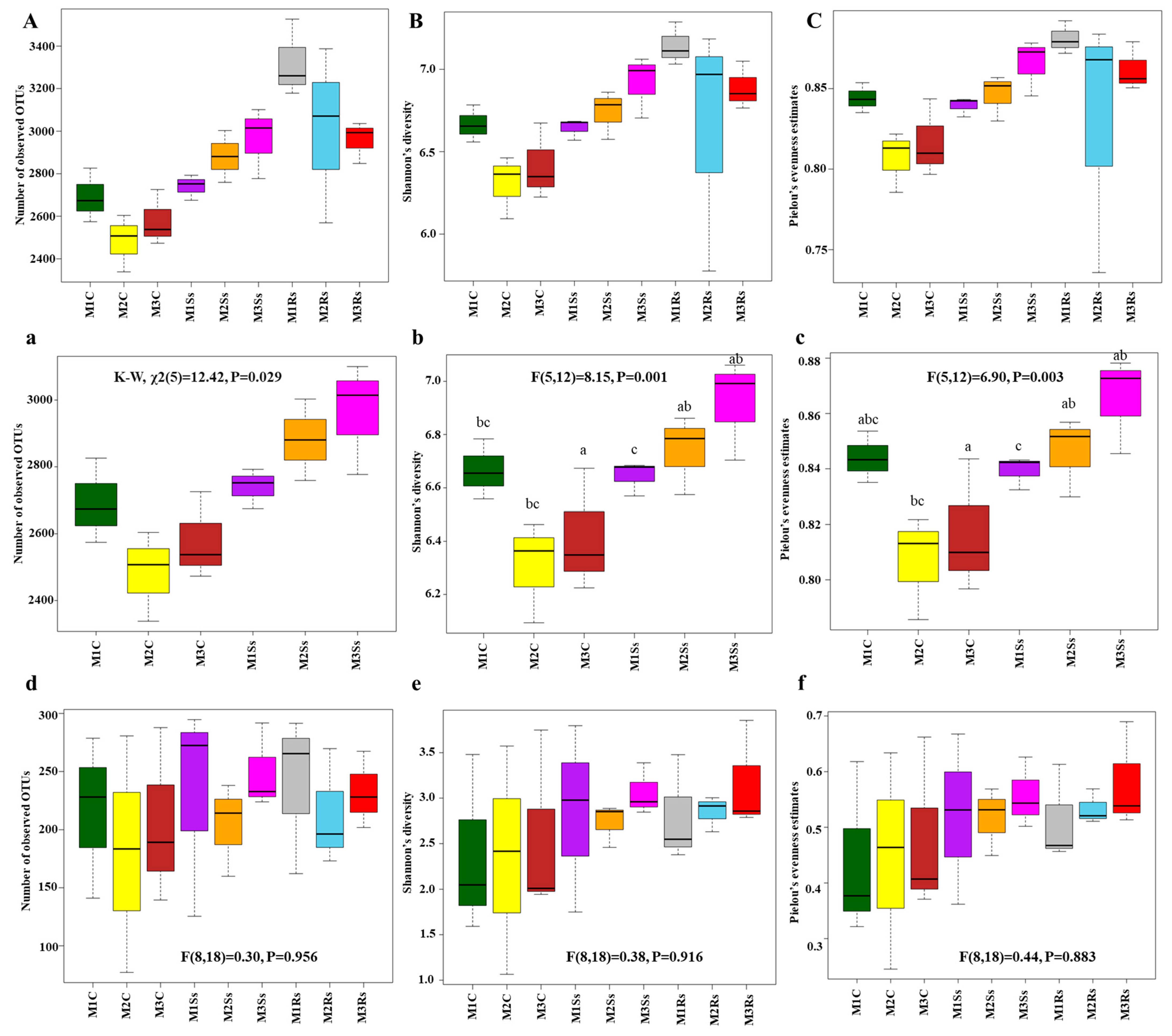
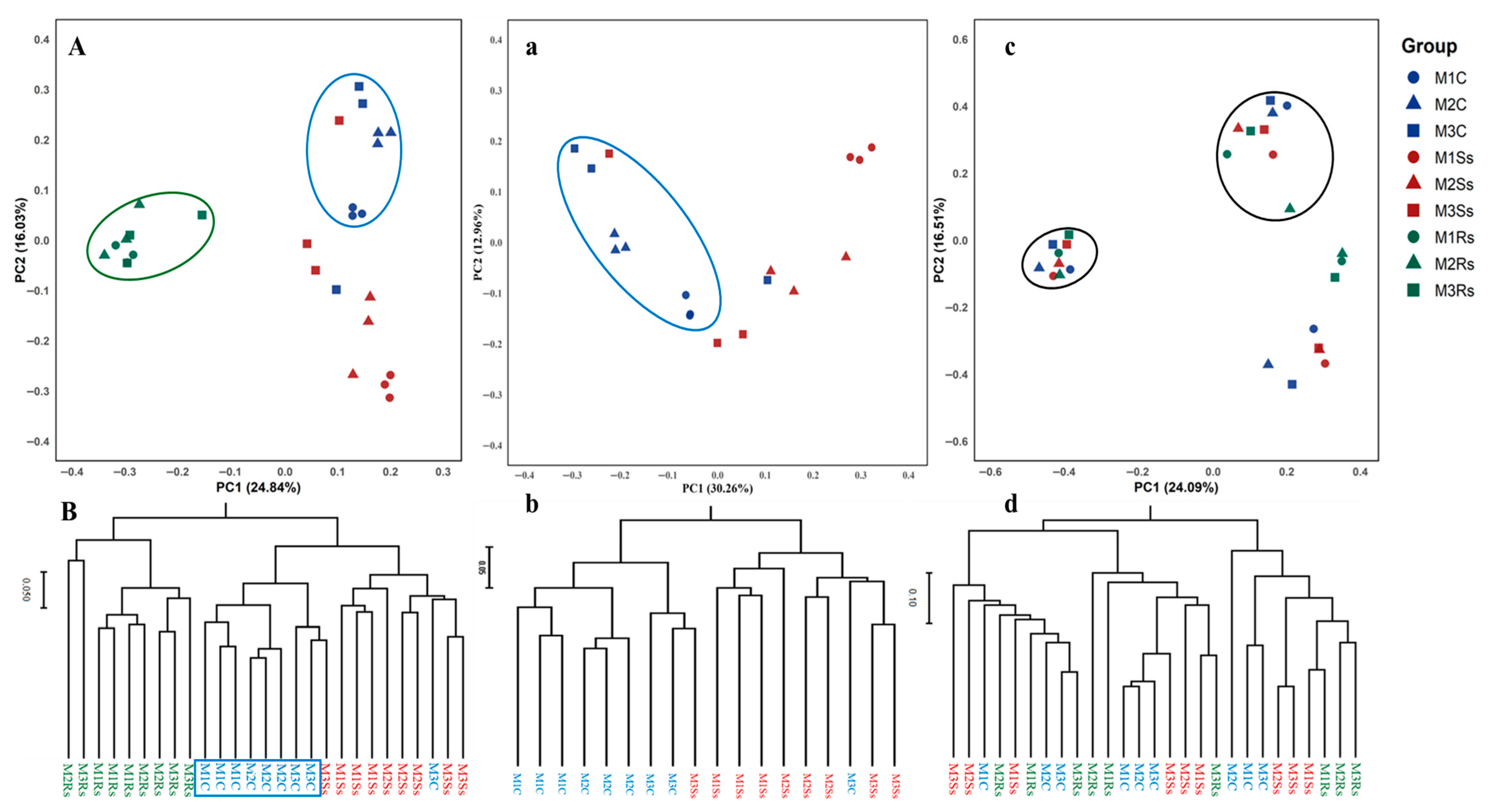
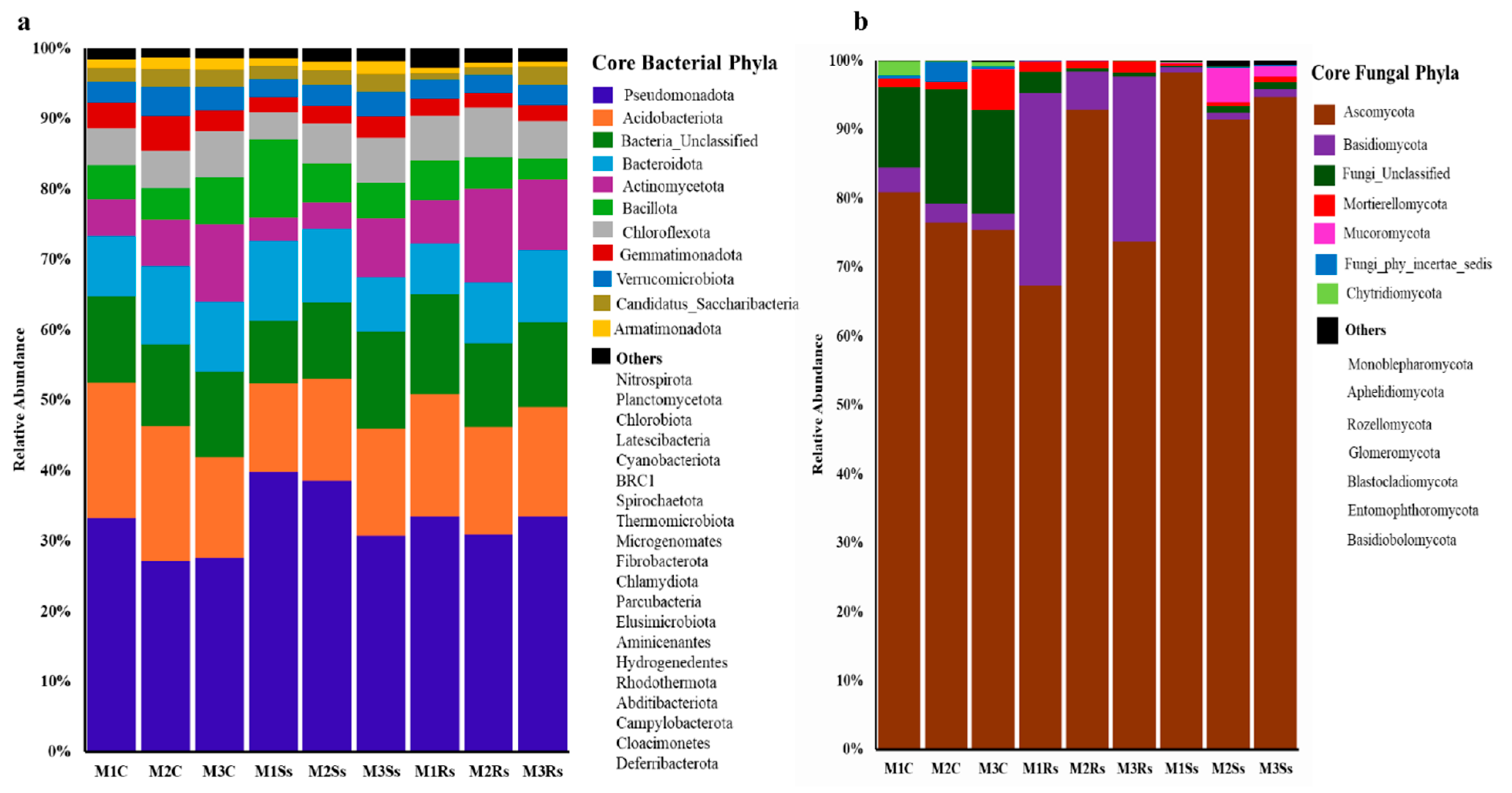
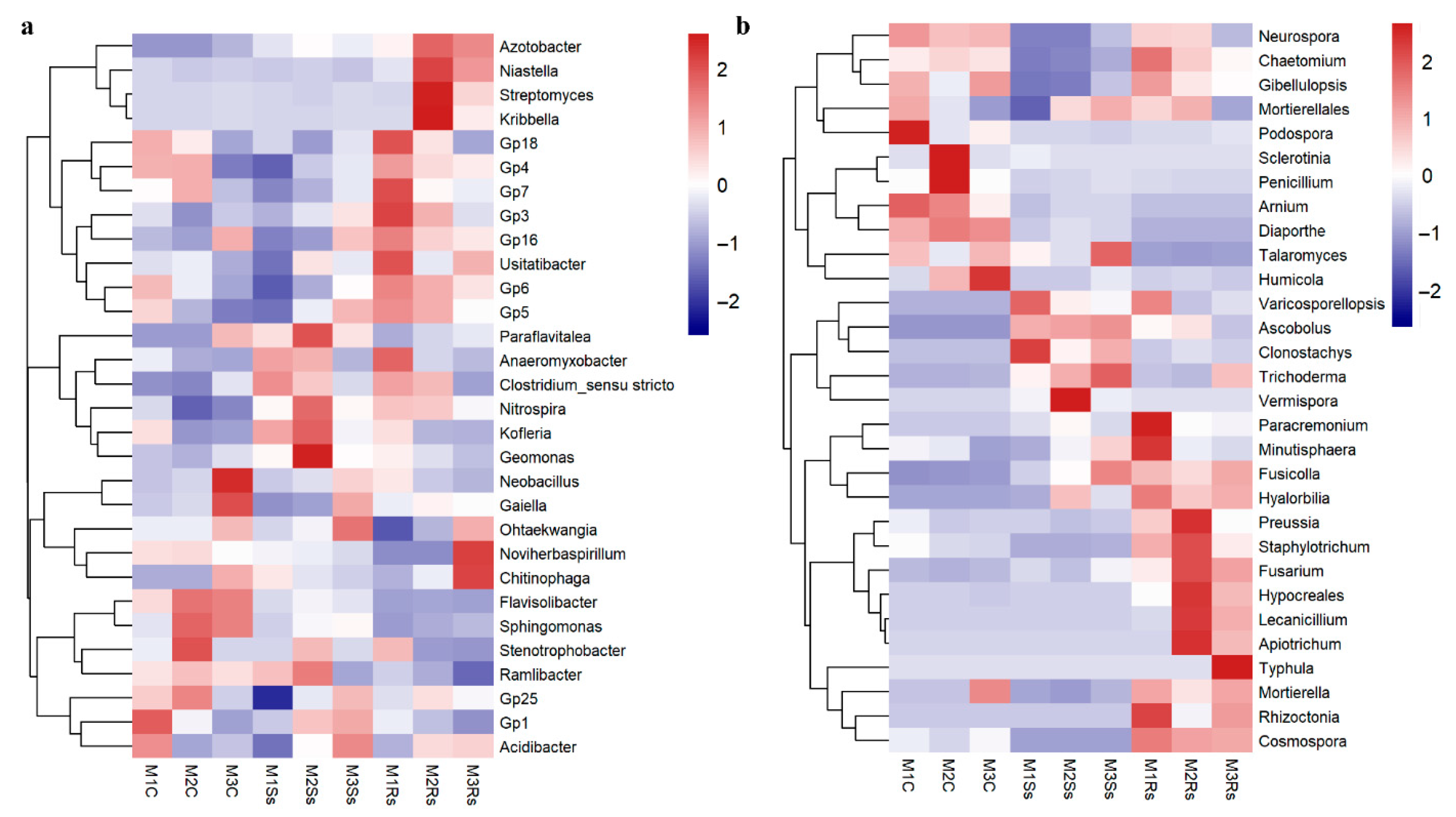
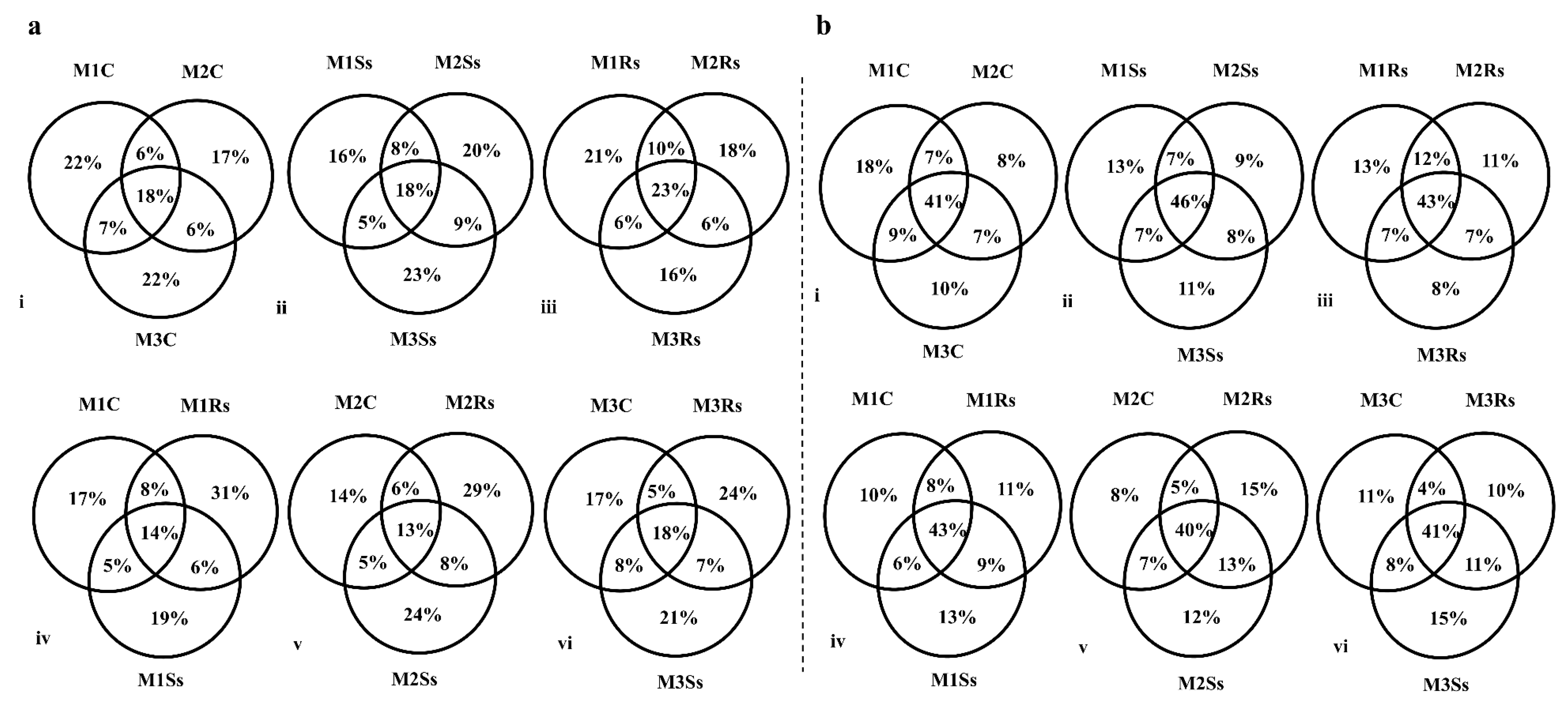
| Effect | Df | Sum of Squares | R2 | F-Value | p-Value | |
|---|---|---|---|---|---|---|
| With Rs Data (for reference) | Treatment | 2 | 0.9476 | 0.3658 | 8.716 | <0.0001 |
| Month | 2 | 0.2585 | 0.0998 | 2.378 | <0.001 | |
| Treatment × Month | 4 | 0.4058 | 0.1567 | 1.866 | <0.001 | |
| Residuals | 18 | 0.9784 | 0.3777 | |||
| Without Rs Data | Treatment | 1 | 0.2512 | 0.1796 | 4.618 | <0.0001 |
| Month | 2 | 0.2773 | 0.1983 | 2.549 | <0.001 | |
| Treatment × Month | 2 | 0.2175 | 0.1555 | 1.999 | <0.01 | |
| Residuals | 12 | 0.6527 | 0.4667 |
| Effect | Df | Sum of Squares | R2 | F-Value | p-Value |
|---|---|---|---|---|---|
| Treatment | 2 | 2.646 | 0.511 | 13.600 | <0.0001 |
| Month | 2 | 0.298 | 0.057 | 1.529 | <0.05 |
| Treatment × Month | 4 | 0.480 | 0.093 | 1.234 | >0.05 |
| Residuals | 18 | 1.751 | 0.338 |
| Sr. No. | Genus or Higher | Treatment | Indicator Value | p-Value |
|---|---|---|---|---|
| 1 | Gp1 | M1C | 0.524 | 0.006 ** |
| 2 | Flavisolibacter | M2C | 0.462 | 0.031 * |
| 3 | Gp25 | M2C | 0.436 | 0.008 ** |
| 4 | Gp4 | M2C | 0.449 | 0.046 * |
| 5 | Tellurimicrobium | M2C | 0.492 | 0.029 * |
| 6 | Mycobacterium | M3C | 0.788 | 0.003 ** |
| 7 | Azonexus | M1Ss | 0.715 | 0.026 * |
| 8 | Ramlibacter | M1Ss | 0.409 | 0.047 * |
| 9 | Candidatus_Koribacter | M2Ss | 0.513 | 0.037 * |
| 10 | Geomonas | M2Ss | 0.697 | 0.009 ** |
| 11 | Kofleria | M2Ss | 0.567 | 0.020 * |
| 12 | Devosia | M3Ss | 0.49 | 0.015 * |
| 13 | Fimbriimonas | M3Ss | 0.642 | 0.003 ** |
| 14 | Anaeromyxobacter | M1Rs | 0.553 | 0.044 * |
| 15 | Clostridium_sensu stricto | M1Rs | 0.57 | 0.023 * |
| 16 | Gp16 | M1Rs | 0.549 | 0.011 * |
| 17 | Gp6 | M1Rs | 0.529 | 0.032 * |
| 18 | Gp7 | M1Rs | 0.577 | 0.013 * |
| 19 | Lysobacter | M1Rs | 0.777 | 0.033 * |
| 20 | Thiobacillus | M1Rs | 0.705 | 0.004 ** |
| 21 | Kribbella | M2Rs | 0.883 | 0.001 ** |
| 22 | Niastella | M2Rs | 0.732 | 0.013 * |
| 23 | Reyranella | M3Rs | 0.551 | 0.030 * |
| Sr. No. | Genus or Higher | Treatment | Indicator Value | p-Value |
|---|---|---|---|---|
| 1 | Talaromyces | M1C | 0.626 | 0.006 ** |
| 2 | Podospora | M1C | 0.878 | 0.017 * |
| 3 | Fusarium | M1C | 0.951 | 0.009 ** |
| 4 | Botryosphaeria | M1C | 0.796 | 0.010 ** |
| 5 | Colletotrichum | M1C | 0.918 | 0.007 ** |
| 6 | Angulomyces | M1C | 0.946 | 0.006 ** |
| 7 | Protocreopsis | M1C | 0.655 | 0.041 * |
| 8 | Penicillium | M2C | 0.873 | 0.040 * |
| 9 | Aspergillus | M2C | 0.737 | 0.042 * |
| 10 | Humicola | M3C | 0.763 | 0.005 ** |
| 11 | Malassezia | M3C | 0.646 | 0.017 * |
| 12 | Lasiodiplodia | M3C | 0.668 | 0.025 * |
| 13 | Vermispora | M2Ss | 0.877 | 0.003 ** |
| 14 | Hyalorbilia | M2Ss | 0.884 | 0.003 ** |
| 15 | Trichoderma | M3Ss | 0.69 | 0.015 * |
| 16 | Talaromyces | M3Ss | 0.562 | 0.027 * |
| 17 | Paracremonium | M1Rs | 0.784 | 0.004 ** |
| 18 | Minutisphaera | M1Rs | 0.539 | 0.024 * |
| 19 | Endophragmiella | M1Rs | 0.897 | 0.028 * |
| 20 | Conocybe | M1Rs | 0.962 | 0.004 ** |
| 21 | Lecanicillium | M2Rs | 0.928 | 0.022 * |
| 22 | Apiotrichum | M2Rs | 0.828 | 0.027 * |
Disclaimer/Publisher’s Note: The statements, opinions and data contained in all publications are solely those of the individual author(s) and contributor(s) and not of MDPI and/or the editor(s). MDPI and/or the editor(s) disclaim responsibility for any injury to people or property resulting from any ideas, methods, instructions or products referred to in the content. |
© 2025 by the authors. Licensee MDPI, Basel, Switzerland. This article is an open access article distributed under the terms and conditions of the Creative Commons Attribution (CC BY) license (https://creativecommons.org/licenses/by/4.0/).
Share and Cite
Mehmood, M.A.; Wang, J.; Cheng, J.; Xie, J.; Jiang, D.; Fu, Y. Sclerotia-Mediated Soil Microbiome Modulation in Rice–Rapeseed Cropping Systems. J. Fungi 2025, 11, 755. https://doi.org/10.3390/jof11100755
Mehmood MA, Wang J, Cheng J, Xie J, Jiang D, Fu Y. Sclerotia-Mediated Soil Microbiome Modulation in Rice–Rapeseed Cropping Systems. Journal of Fungi. 2025; 11(10):755. https://doi.org/10.3390/jof11100755
Chicago/Turabian StyleMehmood, Mirza Abid, Jianguang Wang, Jiasen Cheng, Jiatao Xie, Daohong Jiang, and Yanping Fu. 2025. "Sclerotia-Mediated Soil Microbiome Modulation in Rice–Rapeseed Cropping Systems" Journal of Fungi 11, no. 10: 755. https://doi.org/10.3390/jof11100755
APA StyleMehmood, M. A., Wang, J., Cheng, J., Xie, J., Jiang, D., & Fu, Y. (2025). Sclerotia-Mediated Soil Microbiome Modulation in Rice–Rapeseed Cropping Systems. Journal of Fungi, 11(10), 755. https://doi.org/10.3390/jof11100755







